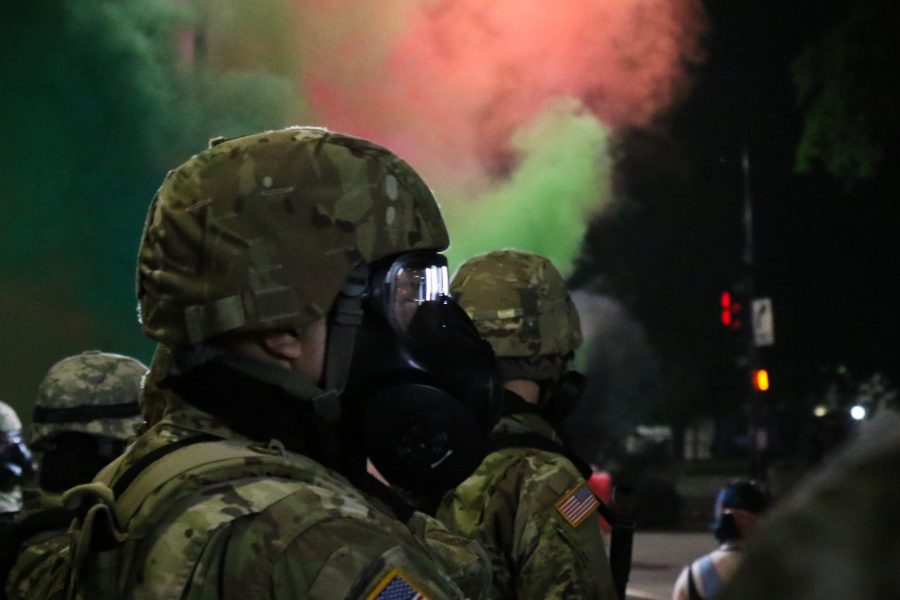Military troops on June 2 continued to respond to nationwide protests over George Floyd’s death, as some lawmakers raised concerns about the prospect of deploying Active-duty service members to settle unrest.
The death of Floyd, a black man who died in police custody May 25 after asphyxiation by a white officer, sparked widespread protests against police brutality and systemic racism. Some protests turned violent, with looting, arson, and gunfire in its wake. President Donald Trump warned on June 1 he might direct Active-duty troops if cities and states failed to quell the violence with their own police and National Guard units.
Lawmakers appeared split over how to respond to the potential use of Active-duty orders under the 1807 Insurrection Act. That federal law allows the Commander in Chief to deploy military troops within the U.S. in case of uprisings.
Rep. Adam Smith (D-Wash.), chairman of the House Armed Services Committee, said June 2 his committee will question top Pentagon officials next week about the potential escalation. On a conference call with reporters, he said the president “is talking about going to war with the citizens of the United States of America, and that is troubling.”
But Rep. Mac Thornberry (R-Texas), the highest-ranking Republican on the committee, cautioned that hauling Defense Secretary Mark Esper and Chairman of the Joint Chiefs of Staff Army Gen. Mark Milley to a hearing could be premature.
“If the President decides to invoke the Insurrection Act and deploy Active-duty forces, it would be appropriate for the committee to hear from the Secretary of Defense and Chairman of the Joint Chiefs of Staff,” Thornberry said. “It would be difficult, in this situation, for the committee to hold hearings about decisions the President has not made.”
But Thornberry worries tapping the Insurrection Act could turn service members into political pawns. “The respect, trust, and support our troops have earned from their fellow citizens is the foundation of their strength and we must be careful not to erode that strength,” he said.
Their remarks followed the build-up of troops in the capital region on June 1-2, in anticipation of deploying them in Washington, D.C., where presidential authority does not require additional steps before troops are deployed. National Guard helicopters flew low over Washington to disperse protesters who remained on the streets after a 7 p.m. curfew, while Esper and Milley walked through downtown D.C. observing the Guard’s work.
The Associated Press reported June 2 that military aircraft over D.C. were acting under Trump’s orders in a “show of force” mission named Operation Themis—a figure in Greek mythology known as the titaness of divine law and order.
As the night went on, a line of KC-135s, C-130s, and C-17s carried in Army and National Guard personnel to Joint Base Andrews, Md., from Utah, South Carolina, Kansas, and New York.
About 700 members of the Army’s 82nd Airborne Division landed at two military bases near Washington, the AP reported. Another 1,400 soldiers are ready to be mobilized, and are armed with riot gear and bayonets.
More than 20,400 National Guard forces across 28 states and the District of Columbia were activated to back up law enforcement as of the morning of June 2, according to the National Guard Bureau. Their ranks swelled by around 3,000 personnel, and added people from five states—Iowa, Massachusetts, Maryland, Missouri, and Nebraska—since the previous day.
National Guard troops helped forcibly clear protestors from a park outside the White House so Trump could walk through Lafayette Square to St. John’s Church to pose with a Bible. The Pentagon pushed back on early reports saying Guardsmen were not armed with rubber bullets or flash bangs, reported Defense One. Trump was accompanied by Esper, Milley, and other administration officials, though a defense official who requested anonymity told reporters the DOD leaders were caught off-guard by the photo op and the decision to remove people from the park.
“It’s a very tough situation that he’s put in, and his style is not the style that others have,” Senate Armed Services Committee Chairman Sen. Jim Inhofe (R-Okla.) told CQ Roll Call about Trump’s threat of military force. “But I think it fit him well … and I don’t criticize him for it.”
An Inhofe spokeswoman did not respond to a request for further comment.
Sen. Jack Reed, the top-ranking Democrat on SASC, took the opposite stance, calling Trump’s rhetoric “irresponsible and destabilizing.”
“The challenges before us can’t be solved by unleashing ‘the unlimited power of our military’ on our fellow Americans,” Reed said. “They can only be solved by unleashing the unlimited power of our citizens striving and living up to the principles and the promise of America.”
A legislative response to the crisis could find its way into this year’s National Defense Authorization Act. Sen. Tim Kaine (D-Va.) said June 2 he plans to introduce an amendment to the fiscal 2021 defense policy bill that would stop DOD from using force against Americans who are “exercising their First Amendment rights.” The Senate will hash out its version of the annual legislation next week.
“The American military must never again be used as the President’s personal palace guard against peaceful protesters,” Kaine said on Twitter.
Brian W. Everstine and Jennifer-Leigh Oprihory contributed to this story.
